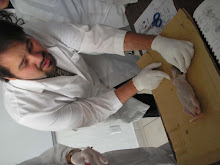Mixtures and Solutions
In today´s class we have begun a new unit called "Mixtures and Solutions".
We began learning such concepts and their relationship with matter.
We began learning such concepts and their relationship with matter.
----------------Matter------------------
l l Substances Mixtures
(can be seperated by chemical means) (Physical)
l l
----------l------------ ------------l-----------
l l l l
Element Compound Homogenous Heterogenous
(not seperated) It is made by two Can not identify parts Its parts can be identified
It is the pure form of something or more atoms
made from one specific atom
It is key to remeber that an element is singular, or just one atom and a compound is two or more atoms.
After viewing the relationships of mixtures and solutions with matter, we discussed common, every day examples of Homogenous and heterogenous.
A great example for Heterogenous is a Salad. You can see the component/ingredients (lettuce,tomato, carrot, etc), which are the parts that can be identified

A common example of Homogenous is coffe. Your not able to identify its igredients or components to make the coffe, which means you are not able to identify its parts.
Next we encountered a new term,
Phase- "the part you identify as a whole (profe Ariel)"
E.g, When you add oil to water you will be able to identify the phases as they are distinctly seperated from each substance to another, this is due to polarity (the charge of particles)
Solutions
There are two parts to a solution
1. Solute-which is the particle to be dissolved
2.Solvent- matrix where the dissolving takes place.
A solute disperses into the solvent, giving you a solution.
!!!!!!!!!!!!!!!!!!!!SOLUTIONS ARE ALWAYS LIQUIDS!!!!!!!!!!!!!!!!!!!!!!!!!!!!!
!!!!!!!!!!!!!!!!!!!! IN ORDER FOR A SOLUTE TO DISSOLVE IN WATER IT HAS TO BE POLAR!!!!!
A good example of a solute and a solvent is chocolate milk
the milk is the solvent and the chocolate powder is the solute.
At the end of class we acknowledged methods for mixture seperation.
The first was filtration- which would seperate the mixture bye the size of its ingredients/components.

The second was Distillaton-is a method of seperating mixtures based on differences in their volatilities in a boiling liquid mixture.
 ...
...
View image on Bing
----------l------------ ------------l-----------
l l l
Element Compound Homogenous Heterogenous
(not seperated) It is made by two Can not identify parts Its parts can be identified
It is the pure form of something or more atoms
made from one specific atom
It is key to remeber that an element is singular, or just one atom and a compound is two or more atoms.
After viewing the relationships of mixtures and solutions with matter, we discussed common, every day examples of Homogenous and heterogenous.
A great example for Heterogenous is a Salad. You can see the component/ingredients (lettuce,tomato, carrot, etc), which are the parts that can be identified

A common example of Homogenous is coffe. Your not able to identify its igredients or components to make the coffe, which means you are not able to identify its parts.
Next we encountered a new term,
Phase- "the part you identify as a whole (profe Ariel)"
E.g, When you add oil to water you will be able to identify the phases as they are distinctly seperated from each substance to another, this is due to polarity (the charge of particles)
Solutions
There are two parts to a solution
1. Solute-which is the particle to be dissolved
2.Solvent- matrix where the dissolving takes place.
A solute disperses into the solvent, giving you a solution.
!!!!!!!!!!!!!!!!!!!!SOLUTIONS ARE ALWAYS LIQUIDS!!!!!!!!!!!!!!!!!!!!!!!
!!!!!!!!!!!!!!!!!!!! IN ORDER FOR A SOLUTE TO DISSOLVE IN WATER IT HAS TO BE POLAR!!!!!
A good example of a solute and a solvent is chocolate milk
the milk is the solvent and the chocolate powder is the solute.
At the end of class we acknowledged methods for mixture seperation.
The first was filtration- which would seperate the mixture bye the size of its ingredients/components.

The second was Distillaton-is a method of seperating mixtures based on differences in their volatilities in a boiling liquid mixture.
 ...
...View image on Bing
Stefano Pinzon

